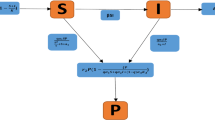Abstract
Backward or subcritical bifurcation is usually considered an undesirable phenomenon in epidemiology since control measures require a reduction in R0 not below one but below a much smaller value. However, there are contexts for which a backward or subcritical bifurcation is not a bad thing; it can even be desirable. Such is the case for any characteristic that can be passed to the next generation (genetically fixed or not) and that increases the effective reproductive rate of the host or the total number of individuals. In the present work, we study an epidemiological model consisting of two classes, susceptible and “infected” individuals; the model considers a characteristic that is passed from “infected” to “susceptible” by direct “contact,” for instance increased fecundity. We analyze conditions for the appearance of a backward or subcritical bifurcation. We discuss the advantage for the population under infection, since the total number of individuals increases at equilibrium. If one takes that as a proxy for increased fitness, it would increase the species’ ecological success. One key element in the model is the fact that “susceptible” individuals have “susceptible” descendants, but “infected” individuals can have “infected” descendants as well as “susceptible” ones. A somehow rare addition for epidemiological models, the fact that “infected” individuals reproduce more rapidly than the susceptible ones, leads to unexpected consequences. Facilitating the “inoculation” increases the total population size, i.e., the backward or subcritical bifurcation appears, with desirable consequences for the population. We show that an increase in the number of susceptible newborns is the main reason for the appearance of a backward or subcritical bifurcation, which induces a bigger population size. We analyze the effect of different combinations of susceptible/infected birth rates. This kind of phenomenon has been observed for bacterial infections in several insects–bacteria and nematodes–bacteria interactions; in particular, it has been intensely studied in interactions of wasps and flies with the genus Wolbachia. It has also been shown in amphibians.











Similar content being viewed by others
References
Arino J, Cooke K (2004) An epidemiology model that includes a leaky vaccine with a general waning function. Discrete Continuous Dyn Syst Ser B 4(2):479–495
Bordenstein SR, Werren JH (2000) Do Wolbachia influence fecundity in Nasonia vitripennis? Heredity (Edinb) 84:54–62. https://doi.org/10.1046/j.1365-2540.2000.00637.x
Brannelly LA, Webb R, Skerratt LF, Berger L (2016) Amphibians with infectious disease increase their reproductive effort: evidence for the terminal investment hypothesis. Open Biol 6:1–24. https://doi.org/10.1098/rsob.150251
Castillo-Chavez C, Song BJ (2004) Dynamical models of tuberculosis and their applications. Math Biosci Eng 1:361–404. https://doi.org/10.3934/mbe.2004.1.361
Fast EM, Toomey ME, Panaram K et al (2011) Wolbachia enhance drosophila stem cell proliferation and target the Germline stem cell niche. Science 80-(334):990–992. https://doi.org/10.1126/science.1209609
Frank K, Frank K, Heald RD (2010) The emerging role of Wolbachia species in heartworm disease. Compend Contin Educ Vet 32:E1–E5
Fry AJ, Palmer MR, Rand DM (2004) Variable fitness effects of Wolbachia infection in Drosophila melanogaster. Heredity (Edinb) 93:379–389. https://doi.org/10.1038/sj.hdy.6800514
Gumel AB (2012) Causes of backward bifurcations in some epidemiological models. J Math Anal Appl 395:355–365. https://doi.org/10.1016/j.jmaa.2012.04.077
Himler AG, Adachi-Hagimori T, Bergen JE et al (2011) Rapid spread of a bacterial symbiont in an invasive whitefly is driven by fitness benefits and female bias. Science 80-(332):254–256. https://doi.org/10.1126/science.1199410
Jiggins FM, Hurst GD, Majerus ME (2000) Sex-ratio-distorting Wolbachia causes sex-role reversal in its butterfly host. Proc Biol Sci 267:69–73. https://doi.org/10.1098/rspb.2000.0968
Kribs-Zaleta CM, Velasco-Hernández JX (2000) A simple vaccination model with multiple endemic states. Math Biosci 164:183–201. https://doi.org/10.1016/S0025-5564(00)00003-1
Moghadas SM (2004) Modelling the effect of imperfect vaccines on disease epidemiology. Discrete Continuous Dyn Syst Ser B 4:999–1012. https://doi.org/10.3934/dcdsb.2004.4.999
Papich MG (2017) Considerations for using minocycline vs doxycycline for treatment of canine heartworm disease. Parasites Vectors 10(2):493
Peerakietkhajorn S, Kato Y, Kasalický V et al (2016) Betaproteobacteria Limnohabitans strains increase fecundity in the crustacean Daphnia magna: symbiotic relationship between major bacterioplankton and zooplankton in freshwater ecosystem. Environ Microbiol 18:2366–2374. https://doi.org/10.1111/1462-2920.12919
Reluga TC, Medlock J (2007) Resistance mechanisms matter in SIR models. Math Biosci Eng 4:553–563. https://doi.org/10.3934/mbe.2007.4.553
Reluga TC, Dahari H, Perelson AS (2009) Analysis of hepatitis C virus infection models with hepatocyte homeostasis. SIAM J Appl Math 69:999–1023. https://doi.org/10.1137/080714579
Rigaud T, Moreau J, Juchault P (1999) Wolbachia infection in the terrestrial isopod Oniscus asellus: sex ratio distortion and effect on fecundity. Heredity (Edinb) 83:469–475. https://doi.org/10.1038/sj.hdy.6885990
Strogatz S (2001) Nonlinear dynamics and chaos: with applications to physics, biology, chemistry and engineering. Westview Press, Cambridge
Van den Driessche P, Watmough J (2002) Reproduction numbers and sub-threshold endemic equilibria for compartmental models of disease transmission. Math Biosci 180:29–48
Venturino E (2007) How diseases affect symbiotic communities. Math Biosci 206:11–30. https://doi.org/10.1016/j.mbs.2006.03.007
Villavicencio-Pulido G, Barradas I (2008) Latency and quarantine vs. backward bifurcation. Ecol Model 214:59–64. https://doi.org/10.1016/j.ecolmodel.2008.01.011
Wang W (2006) Backward bifurcation of an epidemic model with treatment. Math Biosci 201:58–71. https://doi.org/10.1016/j.mbs.2005.12.022
Weeks AR, Stouthamer R (2004) Increased fecundity associated with infection by a cytophaga-like intracellular bacterium in the predatory mite, Metaseiulus occidentalis. Proc Biol Sci 271(Suppl):S193–S195. https://doi.org/10.1098/rsbl.2003.0137
Werren JH, Baldo L, Clark ME (2008) Wolbachia: master manipulators of invertebrate biology. Nat Rev Microbiol 6:741–751. https://doi.org/10.1038/nrmicro1969
Zhang X, Liu X (2008) Backward bifurcation of an epidemic model with saturated treatment function. J Math Anal Appl 348:433–443. https://doi.org/10.1016/j.jmaa.2008.07.042
Zug R, Hammerstein P (2015) Bad guys turned nice? A critical assessment of Wolbachia mutualisms in arthropod hosts. Biol Rev Camb Philos Soc 90:89–111. https://doi.org/10.1111/brv.12098
Author information
Authors and Affiliations
Corresponding author
Additional information
Publisher’s Note
Springer Nature remains neutral with regard to jurisdictional claims in published maps and institutional affiliations.
Rights and permissions
About this article
Cite this article
Barradas, I., Vázquez, V. Backward Bifurcation as a Desirable Phenomenon: Increased Fecundity Through Infection. Bull Math Biol 81, 2029–2050 (2019). https://doi.org/10.1007/s11538-019-00604-1
Received:
Accepted:
Published:
Issue Date:
DOI: https://doi.org/10.1007/s11538-019-00604-1




